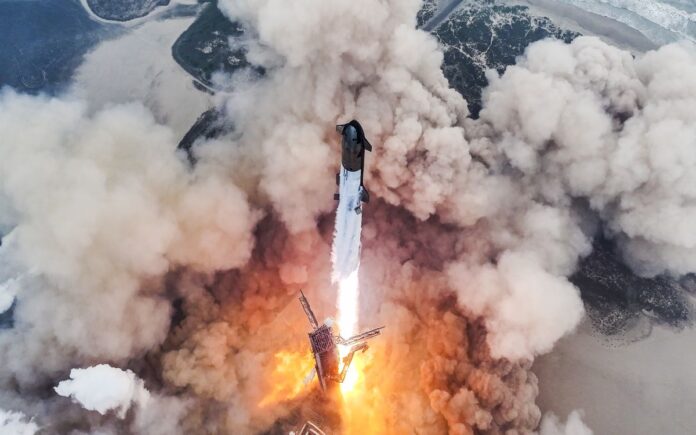Boca Chica, Texas: Elon Musk’s SpaceX achieved a groundbreaking milestone as its Starship rocket completed its inaugural splash-down, propelling the visionary entrepreneur one step closer to his ambitious goal of colonizing Mars.
The towering 400-foot-tall rocket, comprised of the Starship cruise vessel atop its towering Super Heavy rocket booster, lifted off majestically from Boca Chica, Texas, at 8:50 am ET.
Musk hailed the mission as an “epic achievement” after Starship ascended 130 miles above the Earth’s surface and executed a flawless soft landing in the Indian Ocean as planned.
Euphoria swept through the control center as confirmation of the successful mission arrived, prompting SpaceX employees to commemorate the occasion by toasting marshmallows, symbolizing Starship’s “toasty” voyage. Unlike previous attempts marred by midair explosions or re-entry mishaps, Thursday’s mission saw only minor issues with tiles and a damaged flap.
In a remarkable feat, not only did Starship achieve a perfect splashdown, but its booster also executed a precise landing in the Gulf of Mexico just eight minutes after liftoff. This achievement marks a critical milestone in SpaceX’s quest to recover and reuse the Super Heavy booster, a key component of its cost-saving strategy.
Celebrated as the most powerful super heavy-lift launch rocket ever built, Starship’s triumphant return to Earth heralds a new era in space exploration. The launch, a pivotal step toward Musk’s vision of human settlement on Mars, witnessed 32 out of 33 engines igniting as the craft soared into the heavens.
As Starship re-entered the Earth’s atmosphere an hour after liftoff, observers watched with bated breath as the rocket’s flap began to shred and a debris-covered camera lens cracked. Despite the tense moments, SpaceX staff and millions worldwide remained on edge, awaiting confirmation of a successful splashdown following the rocket’s first-ever landing burn.
Also Read | Kremlin Issues Warning Amid Arms Supply Rift with Ukraine
The live feed intermittently flickered as the rocket cooled, eliciting applause each time it resumed, indicating that Starship continued to transmit data as it decelerated to 620 miles per hour—below the speed of sound.
“The payload for these flight tests is data. Building upon what we achieved during Starship’s third flight test, our primary goal today is to get through the extreme heat of reentry,” SpaceX posted on X.
The flight trajectory mirrored the third test conducted in March, where Starship flew for 49 minutes before ultimately succumbing during re-entry over the Indian Ocean. Since then, SpaceX has implemented numerous software and hardware upgrades.
Also Read | US Takes Action to Strengthen Internet Security Amid Chinese Carrier Concerns
In 2020, Musk unveiled his ambitious plan for Starship to ferry humans to Mars, envisioning one million settlers on the Red Planet by 2025—an endeavor requiring around three flights per day and a total of 1,000 flights annually. With 2025 looming, the billionaire reiterated his commitment to Martian colonization in a recent post on X.
“I’m going to colonize Mars. My mission in life is to make mankind a multiplanetary civilization,” Musk’s post declared.
Former President Barack Obama, speaking at a renewable energy conference in Paris a day before the mission, addressed the topic of Mars colonization, cautioning against neglecting Earth’s environmental challenges.
Also Read | Avian Flu Strikes Minnesota: First Dairy Herd Affected in State
“While Thursday’s mission did not unfold entirely as planned, it marked the furthest journey undertaken by a Starship rocket to date.”
Despite encountering setbacks, SpaceX remains undeterred in its pursuit of space exploration. Each launch attempt, even those resulting in fiery destruction, contributes valuable data to SpaceX’s iterative development process.
As SpaceX continues to push the boundaries of space travel, NASA expressed solidarity in its shared vision of venturing beyond Earth’s confines.
“Together, we are making great strides through Artemis to return humanity to the Moon—then look onward to Mars.”



